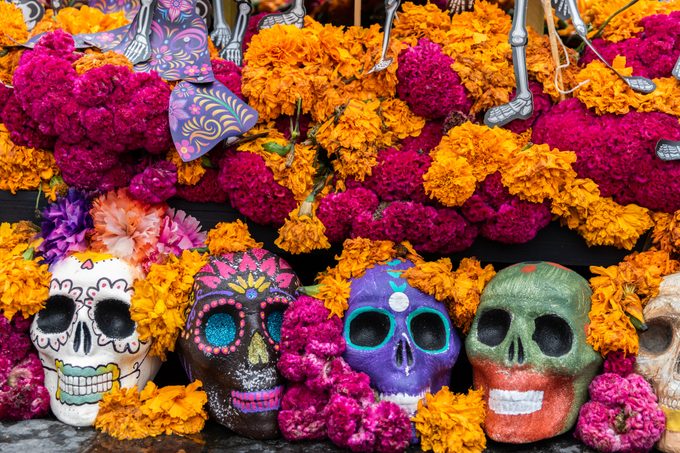Curious when Day of the Dead is and why it matters? Learn the meaning behind this uniquely festive Latin American tradition.

When Is Day of the Dead? The History Behind Día de los Muertos

Let’s get one thing straight: Día de los Muertos, or Day of the Dead, isn’t just “Mexican Halloween.” Sure, you might spot Day of the Dead–inspired Halloween decor, but the two holidays fall on different days and involve different cultures and traditions. So when is Day of the Dead, and what is it all about?
Día de los Muertos is often included in lists of Halloween traditions around the world, even though it has its own rich identity. Read on to find out when Day of the Dead is, what it’s all about, how it’s celebrated and more facts about this fascinating holiday.
Get Reader’s Digest’s Read Up newsletter for more history, humor, tech and fun facts all week long.
What is Day of the Dead?
On this day, the dead are welcomed back into the world of the living by friends and relatives seeking to keep their memory alive. Its popularity among American audiences grew significantly after the release of Coco, one of the most beloved Disney Halloween movies for kids. The modern-day animated classic brought to life the central idea that the deceased are never truly gone until there is no one left to remember them.
In Mexican culture, the dead are honored with brightly decorated altars, or ofrendas—offerings that include candles, bowls of water and many of the foods they enjoyed during their lifetime. It’s the one day each year when the line between the living and the dead blurs, bringing both together in a vibrant and meaningful celebration. You’ll find cemeteries across Latin America filled with friends and family of the deceased, who await the return of the spirits of their loved ones.
When is Day of the Dead?
Día de los Muertos is celebrated on Nov. 1 and 2. Originally, the Aztecs celebrated the holiday in the month of August. With the arrival of the Spanish colonizers in the 16th century, traditional indigenous holidays were merged with those related to Christianity. As Día de los Muertos shares similarities with All Souls Day (more on that below), the Spanish shifted the holiday to the first of November.
What’s the history of Day of the Dead?
Still wondering, What is Day of the Dead, specifically? It’s best understood in the context of history—and this holiday’s origins stretch back thousands of years.
Día de los Muertos stems from the Meso-American indigenous tradition. Historically, the holiday was a celebration of the return of the Aztec goddess Mictecacihuatl to the world of the living. Along with her husband, Mictlantecuhtli, the goddess presided over the dead and the underworld. Mictecacihuatl was associated with both death and resurrection.
When the Spanish arrived in what is now Mexico, they witnessed the monthlong celebration in honor of Mictecacihuatl taking place in what corresponds with our modern calendar of July and August.
What happens on Day of the Dead?

As the popularity of Día de los Muertos continues to grow, Latin Americans and others who appreciate the tradition have embraced the idea of constructing remembrance altars, or ofrendas, in their homes. The altars are made up of three levels, representing the underworld, the world of the living and the afterlife.
In Mexico City, the tradition now includes an annual parade attended by thousands. Both spectators and participants wear vibrant representations of La Catrina and El Catrin—skeletal figures originally created by Mexican illustrator José Guadalupe Posada in the early 20th century—complete with colorful Calavera face paint symbolizing death. The tradition is a nod to the ancient Indigenous celebration: People once wore masks made of wood, skulls and other materials to honor the goddess Mictecacihuatl.
In other areas of Latin America where Dia de los Muertos is celebrated, many take a trip to the cemetery to visit the graves of loved ones. Rather than places of mourning, cemeteries transform into festive scenes where vendors sell traditional foods and decorations, including paper flowers for the graves.
What’s the difference between Day of the Dead and All Souls Day?
Though Día de los Muertos and All Souls Day are both very old traditions, one stems from indigenous rituals and the other from old Christian practices.
Meso-American cultures had celebrated Día de los Muertos centuries before the arrival of the Spanish. Historians believe the tradition is more than 3,000 years old and may trace back to the ancient Toltec culture. Día de los Muertos is a joyful celebration, where the dead and the living are reunited.
All Souls Day, celebrated around the world, falls on Nov. 2 and has been observed as far back as 998 A.D. Established by Abbot Odilo of France, All Souls Day has become a Catholic tradition in which people pray for the souls of the dead who are in purgatory.
Day of the Dead facts
- American audiences may associate Día de los Muertos with Mexican culture, but the holiday is also celebrated in many other Latin American countries.
- Marigolds, known as flor de muertos (“flowers of the dead”), are bright orange blooms used to decorate the altars, or ofrendas, and the graves of loved ones.
- The parade in Mexico City began in 2016 and draws thousands of viewers and participants every year.
- The 2015 James Bond movie Spectre featured a fictitious Día de los Muertos parade in Mexico City, which later inspired the government to create a real one.
- La Catrina, Posada’s iconic caricature, was created around 1910 to mock the Mexican aristocracy. She has since become a symbol of Día de los Muertos and a reminder that in death, everyone is equal.
Why trust us
At Reader’s Digest, we’re committed to producing high-quality content by writers with expertise and experience in their field in consultation with relevant, qualified experts. We rely on reputable primary sources, including government and professional organizations and academic institutions as well as our writers’ personal experiences where appropriate. We verify all facts and data, back them with credible sourcing and revisit them over time to ensure they remain accurate and up to date. Read more about our team, our contributors and our editorial policies.
Sources:
- Smithsonian American Art Museum: “Traditions and Change: The Transformation of Día de los Muertos in the United States”
- The Conversation: “Day of the Dead: From Aztec goddess worship to modern Mexican celebration”























